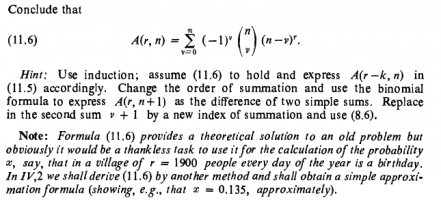Win_odd Dhamnekar
Junior Member
- Joined
- Aug 14, 2018
- Messages
- 207
This problem refers to classical occupancy problem i-e r balls are distributed among n cells and each of the \(\displaystyle n^r\) possible distributions has probability \(\displaystyle n^{-r}\)



Then the author W. Feller says to replace in the second sum v + 1 by a new index of summation and use following important property of binomial theorem.
for any number x and for any integer r,
\(\displaystyle \binom{x}{r-1} + \binom{x}{r} = \binom{x+1}{r}\)



Then the author W. Feller says to replace in the second sum v + 1 by a new index of summation and use following important property of binomial theorem.
for any number x and for any integer r,
\(\displaystyle \binom{x}{r-1} + \binom{x}{r} = \binom{x+1}{r}\)


